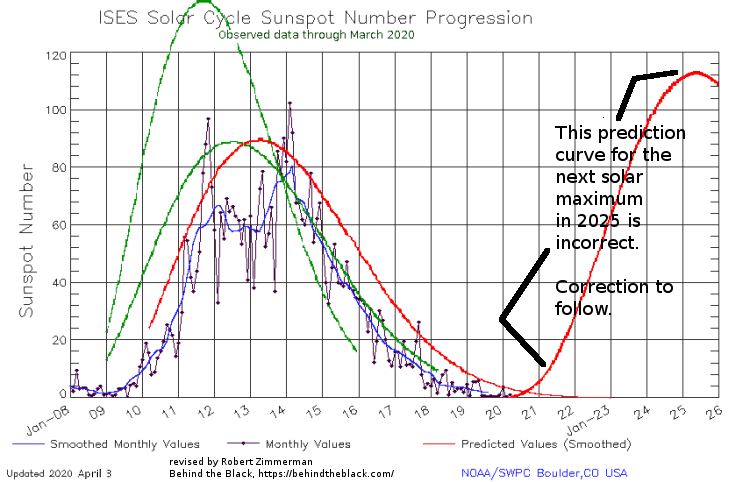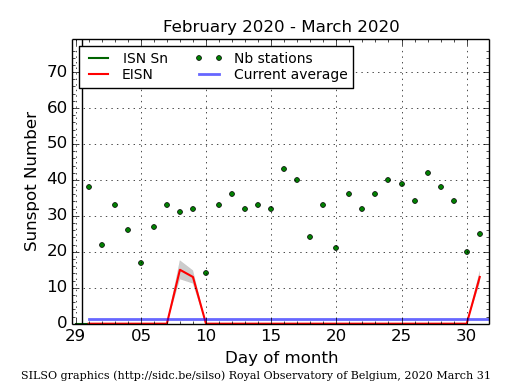Sunspot update: tiny uptick in March activity
UPDATE: In doing some analysis and prep work for future updates, I have discovered that the graph below is in error in its placement of the prediction for the next solar maximum in 2025. I have revised the graph below to note the error. On April 6, 2020 I posted an updated graph.
My original post:
—————————
This week NOAA unveiled a major revamping of the graph it has used for the past decade-plus to show the monthly progression of the sunspot cycle, and that I have been using since the start of this website to do my monthly sunspot updates.
Overall they did a very nice job. The new graph not only shows the present state of the cycle, but it allows you to zoom in or out on this cycle as well as all sunspot cycles going back to 1750, about the time the sunspot cycle was first recognized and the sunspot count became reliable.
The new graph also includes a new more precise prediction for the upcoming solar cycle, forecasting the peak in 2025, higher than the weak solar maximum that has just passed. I have taken the old graph (see my last update on March 12, 2020) and revised it to place this new prediction in context with the previous cycle. I have also added the March sunspot numbers to it.

The graph above has been modified to show the predictions of the solar science community for both the previous and upcoming solar maximums. The green curves show the community’s two original predictions from April 2007 for the previous maximum, with half the scientists predicting a very strong maximum and half predicting a weak one. The red curve through 2020 is their revised May 2009 prediction. The red curve after 2020 is the new prediction, first posted by NOAA in April 2020.

Despite the high prediction for the 2025 maximum, the overall paucity of sunspots over the last year has continued, with March having only two sunspots, as indicated by the SILSO graph to the right. Both spots had magnetic polarities linking them to upcoming solar maximum, not the older now fading cycle.
Since June 2019 the Sun has averaged between one or two sunspots per month, with the number of spots linked to the new cycle steadily increasing over time. Though the numbers remain tiny, far lower than seen during the last solar minimum — considered the deepest and longest in a century — the new cycle sunspots strongly suggest we will have a solar maximum in the next five years, rather than experience a grand minimum with no sunspots for decades.
The new NOAA graph also makes it very easy to compare today’s minimum with all past minimums. A quick scan shows that we had similar blank stretches during the 1810, 1823, and 1912 minimums. In both centuries we saw two consecutive weak maximums linked to these deep minimums. All this suggests to me that the next maximum will be weak too. Some scientists agree, with some not discounting the possibility of a grand minimum.
Tracking and predicting the strength of the sunspot cycle is not a subject merely of interest to nerds. It bears importance to the entire climate change debate, as there is circumstantial evidence that a long term lack of sunspots results in a cooling of the climate on Earth. During the last grand minimum in the 1660s we experienced what has been dubbed the Little Ice Age, with failed crops, famines, and years with no summer. Similarly, in the weak maximums early in the 1800s and 1900s, as well as the weak minimum in 2009, the global temperatures appeared to drop as well.
The link between the Sun and these cool periods however is still not confirmed. Other factors, such as major volcanic eruptions, could have brought on some of those cool periods. If the Sun however did cause those periods of cooling, than all climate models predicting global warming will need to be rewritten, since most do not factor in any solar fluctuations. In fact, they all assume a constant Sun, something that might not be true.
All remains uncertain however. All we really can do is continue observations and try to learn more.
But then, isn’t that what real science is always about?
On Christmas Eve 1968 three Americans became the first humans to visit another world. What they did to celebrate was unexpected and profound, and will be remembered throughout all human history. Genesis: the Story of Apollo 8, Robert Zimmerman's classic history of humanity's first journey to another world, tells that story, and it is now available as both an ebook and an audiobook, both with a foreword by Valerie Anders and a new introduction by Robert Zimmerman.
The print edition can be purchased at Amazon or from any other book seller. If you want an autographed copy the price is $60 for the hardback and $45 for the paperback, plus $8 shipping for each. Go here for purchasing details. The ebook is available everywhere for $5.99 (before discount) at amazon, or direct from my ebook publisher, ebookit. If you buy it from ebookit you don't support the big tech companies and the author gets a bigger cut much sooner.
The audiobook is also available at all these vendors, and is also free with a 30-day trial membership to Audible.
"Not simply about one mission, [Genesis] is also the history of America's quest for the moon... Zimmerman has done a masterful job of tying disparate events together into a solid account of one of America's greatest human triumphs."--San Antonio Express-News


Did I miss the science that leads to NASA’s prediction of the new solar maximum value?
Bill: Unlike the 2007 and 2009 predictions (which were announced with great fanfare), when they released their prediction for the 2025 maximum, NOAA did not make a big deal, with a press conference etc. The press release, on April 5, 2019, was so quietly released in fact that I had not heard of it when I first wrote my April 8, 2019 sunspot update. Moreover, that release did not include a graph illustrating the predicted rise and fall of sunspot activity, as done with the previous predictions. They kept their overall prediction somewhat vague. As I noted in an update to that April 8th update:
They have now released that curve, in such a way that it will make it harder for journalists like me to include it in my future updates. As with their old graphs, as the actual numbers roll in they will erase the red curve of their prediction, hiding how good or bad it was.
With the old graph I could cut and paste the curve back in. Now I will have to do a lot of extra work, since the new graph is not a graphics file I can simply download and revise. I intend to do it, though in what manner I have not yet determined.
Bill: One additional point: The prediction has nothing to do with NASA.
It would be very informative to know what factors they have looked at to come to this prediction.
Should cycle 25 be lower than 24, then the entrance into a grand minimum is more certain.
We know so little (while we think we know so much), that I will wait and see.
Why does NOAA put the time and effort into making a predictions? Especially given their record on the accuracy of their past predictions? Would we all be be served if they focused on analyzing and explaining the current data?
The predictions are useful to the audience because it shows us how often they are wrong. This is also why the predictions are memory holed, because the scientific community doesn’t like people to know how often they are wrong.
It would be nice to know why they think the next cycle would peak where they predict.
Perhaps you could recreate the previous predictions using the slope and put those estimated monthly numbers into your own graph, unless there are monthly sunspot predictions you can find. The current prediction has month by month predictions. Then its just updating the chart with the actual observations every month. There might be a site that has the sunspot numbers in a form you can use a macro to pull them off their site with whatever spreadsheet program you use.
Then it would just be hit the import button, or update the month’s count, and copy/paste the updated chart.
John asked: “Why does NOAA put the time and effort into making a predictions?”
Without predictions, it is difficult to judge the skill of the models that are created by various solar astrophysics labs around the country and the world. It is the differences between the model predictions and the reality that get the scientists to ask the important questions about why the differences existed. It is in answering these questions that improves the models for the next solar maximum. Or so the scientists hope.
wooden wrote: “This is also why the predictions are memory holed, because the scientific community doesn’t like people to know how often they are wrong.”
This may be true of the climate science community (which once “lost” crucial data used in the creation of a popular climate theory, when that data was requested for analysis by other scientists — this loss came after the scientist wrote an email to a colleague that he would rather destroy that data than let anyone question it), but solar astrophysicists get excited about their hypotheses.
At the time that I was working in a solar astrophysics lab magnetic coupling was a hypothesis trying to explain why the corona is hotter than the sun’s surface. It has been shown since then that there is not enough energy in this phenomenon to explain the additional temperature, but it was a nice try.
Because the climate community does not seriously consider solar activity to be important to Earth’s climate, I doubt that they have yet to corrupt the solar astrophysics science.
Edward: My experience in dealing with the solar scientist community is that some have been corrupted by politics, either office politics (to protect their egos from failure and bad predictions) or power politics (protecting modern human-caused global warming models from being ruined because the Sun is more important than predicted).
Though they are not yet a big part of that community, their power is disproportionate because many are secure in government jobs.
Gentlemen, thank you for sharing your thoughts.
All,
Note the update at the top of the post. My placement of the prediction for the upcoming maximum was in error. I will post a new sunspot update tomorrow.
All,
Please see today’s post, NOAA’s prediction for the next solar maximum, for an accurate portrayal of NOAA’s prediction for the next solar maximum.